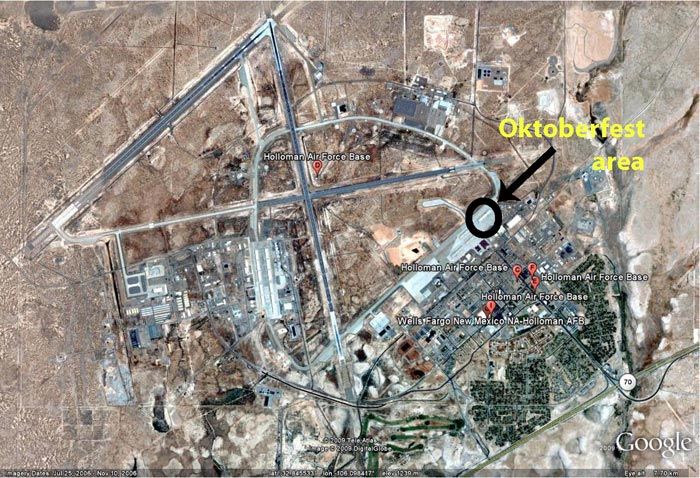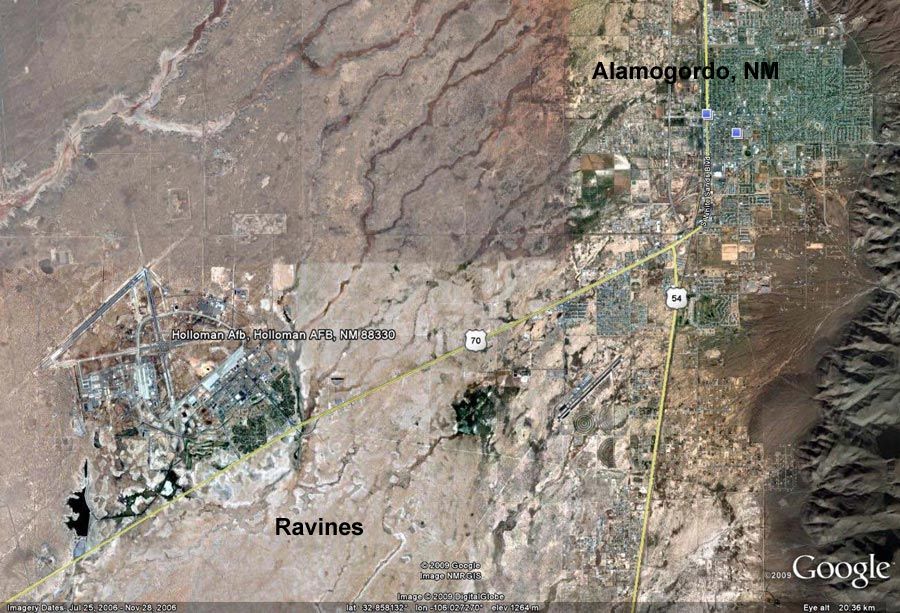Multiple Universes RV Project Session Download Page
Overview: These sessions were done in August 2009, and they describe the 13th Annual Oktoberfest at Holloman Airforce Base in Alamogordo New Mexico that took place on Saturday, 26 September 2009. Please click on the yellow banner below to see the full target specification, which includes multiple pictures and a YouTube video. This uses remote viewing to predict a future event.
"Clarity scores" follow the session comments below, beginning with a "C" followed by a number. Clarity scores evaluate the sessions with respect to the known and verifiable characteristics of the target. Clarity scores can range from 0 to 3, and they convey the following meaning:
3: The known and verifiable target aspects are described exceptionally well with few, minor, or no decoding errors.
2: The known and verifiable target aspects are described well. There may be some notable decoding errors.
1: The known and verifiable target aspects are described minimally. There may also be significant decoding errors.
0: The known and verifiable target aspects are described very poorly or not at all.
Decoding errors occur when a remote viewer perceives something that is real at the target, but the description of this perception is not entirely correct. Again, the perception is real, but the description of it is only partially accurate. For example, if someone describes a city with tall skyscrapers as a mountain range, that is a decoding error. The perception is correct in terms of the topology, but the characterization of it as a mountain range is incorrect. Also, if a person places trees or animals in a barren natural landscape, that is a decoding error. The perception of a natural landscape is correct, but the conscious mind added things that it thought would be normal for a natural landscape. Experienced remote viewers are trained to minimize decoding errors, and analysts are trained to discount decoding errors that would be more common with certain types of targets.
Some of the clarity scores are followed by a "UEP" marker, which stands for "Unique Element Portrayal." A Unique Element Portrayal indicator, or UEP marker, signifies that the session contains at least one description that unambiguously describes a unique element in the target. A unique target element is some target component that is not a normal element in other targets. For example, flat land would not be a unique target element since many targets are located on flat land. However, something much more specific with, say, a unique shape, purpose, or energy would be a possible unique target element. Unique Element Portrayals often involve highly specific sketches of some element of the target, although a highly specific verbal description could also qualify. If the session does contain at least one Unique Element Portrayal, then a UEP marker is appended to the clarity score. Sessions with clarity scores of 3 that are also appended with UEP markers are normally considered unambiguous evidence of profound remote viewing, and such sessions should normally satisfy the judging concerns of all reasonable people as being accurate descriptions of the given target.
Tasker for this experiment: Lyn Buchanan
Experimental Design Architect and Analyst: Courtney Brown
Date target was assigned: 5 October 2009
Nature of the target: An event that occurs during September 2009
Number of sessions conducted in August and posted as of 2 September 2009: 9
| Viewer Name | Sessions done in August describing a September event | ||||
| CRV Sessions: | Encrypted | Decrypted | Comments | ||
| Daz Smith | Download | Download | This is a good session despite the viewer not having picked up the people congregating at the target event. The viewer correctly describes an area with many structures, some with flat-topped roofs. The viewer also describes at least one manmade object that is descending into the target area, an entirely appropriate perception for an airport where jets regularly land. The only major decoding error in the session is the interpretation by the viewer that one descending object may be associated with a negative event, such as a crash with the associated loss of life. Normally, an analyst would discount such interpretations, and focus more on the low-level physical descriptions of the target. This session is a good example of how different viewers will perceive different aspects of a target, and multiple viewers are useful for an analyst to obtain a more complete overview of the target's gestalts. C2 | ||
| HRVG Sessions: | |||||
| Dick | Download | Download | This is a good session where the viewer correctly describes the target area as containing structures (with flat-topped roofs) together with surrounding subjects. The viewer also describes the general terrain surrounding the target area as dry with nearby ravines or gullies (especially south of the airforce base), sparce vegetation, and numerous surface irregularities. On the last page of the session, the viewer correctly locates the nearby town of Alamogordo, NM to the northeast of the target area. See the second picture below to see the location of the ravines south of the airforce base as well as the location of Alamogordo to the northeast of the airforce base, all of which corresponds well with this viewer's data, especially as summarized on the last page of the session. The viewer does not describe the subjects congregating for the target event, but the viewer does describe the general topology of the target area. Again, the viewer does correctly describe the general flat-topped topology of many of the structures at the target, as seen on pages 8 and 13 of the session (pdf numbering). The viewer incorrectly adds an interpretation to the session of subjects searching for something. But such an interpretation would normally be discarded in analysis. The viewer does correctly describe the types of informal clothing worn by the subjects at the target event (see especially page 17, pdf numbering). C3:UEP | ||
| Ace Grill Kid | Download | Download | This is a short free-form session (not following HRVG methodology) where the viewer correctly perceives the subjects, the American flag, and even the ever-present pitchers (of beer) that were present at the target event (see especially page 3, pdf numbering). The only clear error in the session is the perception of a fish. Note that while this is a German airforce base, both the German and American flags are displayed at the base. C2 | ||
| Debra | Download | Download | This is a very interesting session to study for the purposes of understanding the challenges faced by a viewer during the remote-viewing process. This session is essentially composed of two halves. The first half correctly describes structures with flat-topped roofs and subjects, all of which seem associated with some type of technology. These are appropriate perceptions for an airforce base. However, the viewer inappropriately mixes these perceptions with an interpretation of a research facility. At the half-way point of the session, the viewer correctly suspects that the interpretation is incorrect and then tries to correct this by launching off in a new direction for the session. This very often invites the conscious mind to intervene in the session (and thus derail the session completely), which is clearly what happened next when the viewer begins to describe a water-related scene. Web site visitors should observe that the original low-level physical descriptions were correct, and that the viewer's interpretation was incorrect. Viewers are always instructed not to interpret their data, but sometimes this happens anyway, and analysts are trained to remove such interpretations from the analysis of low-level perceptual data. What is particularly interesting in this case is that the viewer correctly understood that the interpretation overlay was incorrect. C1 | ||
| Maria 1 (first session) | Download | Download | This session develops interpretations that differ from actual target characteristics. C0 | ||
| Maria 2 (second session) | Download | Download | This session develops interpretations that differ from actual target characteristics. C0 | ||
| Anne | Download | Download | This is an excellent session that describes the airport and its surrounding environment well. The viewer clearly describes jets landing and/or flying over the airport, dry plains surrounding the airport, some ravines near the airport, structures appropriate for the airport, and young people engaged in conversation. All of these perceptions are appropriate for the target. There appears to be a decoding error in which the viewer perceives a crashed aircraft. This may or may not have actually occurred at the site. Sometimes viewers pick up significant events at a target site even if the event did not happen at the specified target time, in the sense that the events "bleed through" time. C3:UEP | ||
| Sita | Download | Download | While this session develops interpretations that differ from actual target characteristics, the viewer nonetheless does perceive structures with flat tops. C1 | ||
| Michele | Download | Download | This is a new viewer, and the data are minimal. However, the viewer does perceive an event that involves crowds taking pictures together with aircraft. She interprets this as an "airshow," which is an understandable misinterpretation given the setting of the event at an airforce base and the presence of numerous aircraft in the area (both on the ground and in the air). This is an excellent session for a new viewer. C1 | ||
SUMMARY OF RESULTS |
This is an interesting collection of sessions for this experiment. In general, the viewers tended to correctly describe the topology of the target area, with particular emphasis on the flat-topped nature of many airport structures. For this experiment, the viewers did not describe the target subjects in great detail, and this was probably due to the fact the subjects at the target were not focused on any one thing. They were milling about more generally, with essentially no "group focus." The lack of a group focus probably caused the viewers to downplay the importance of the subjects at the target site. This often happens with remote viewing when subjects at a target location are not really doing any one thing in particular. Please click on the yellow banner above to see the full target specification, which includes multiple pictures and a YouTube video.

